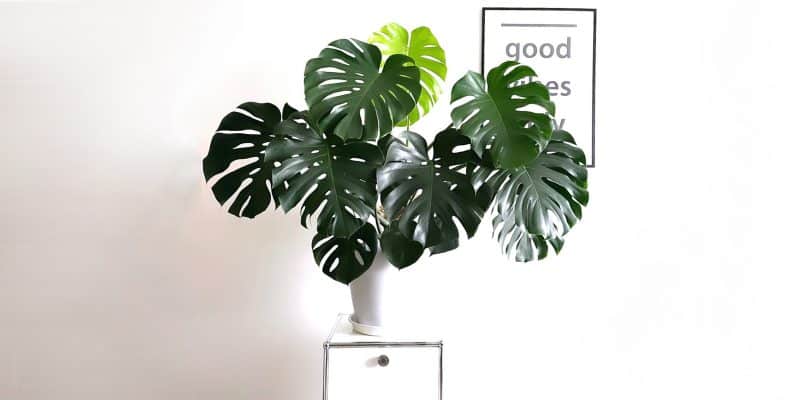We’ve got a real treat for you today: our complete Monstera deliciosa care guide.
This fabulously funky plant is famous for its show-stopping split leaves and singular personality, making it the perfect addition to any plant collection.
Picture this: these nimble climbing plants, making their way up a towering tree trunk, their big, glossy leaves unfurling majestically to reveal distinctive splits and holes — a sight to behold, right?
Well, now imagine that same tropical beauty gracing your very own living space.
The best part? Monstera deliciosa is surprisingly low-maintenance (yeah, we were shocked too).
In this article, we’ll dish out all the juicy details on how to keep your plant happy and thriving, including vital info on propagation, lighting, humidity, and how to tackle those pesky plant problems that might crop up from time to time.
So, why not join us on this leafy escapade? We promise you’ll be head over heels for Monstera deliciosa in no time. Plus, you’ll be able to impress all your friends as you tell them all about Monster Fruit.
Win-win, right?
Table of Contents
Monstera Deliciosa Care Guide
History, habitat, and characteristics
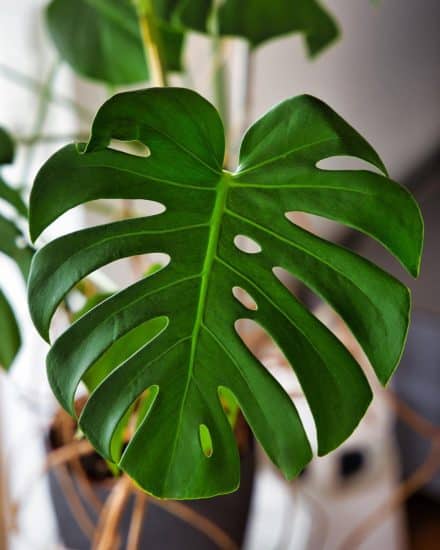
Ever wanted to bring a slice of the tropics right into your living room? Meet Monstera deliciosa. Just imagine it, exploring along the forest floor, searching high and low for a tree trunk to call its new home.
A true tropical adventurer, right?
Have you ever wondered why Monstera deliciosa leaves are full of those funky holes? These natural perforations are believed to help this tropical plant withstand heavy rains and strong winds in their native habitat. A pretty crafty plant, don’t you think?
In the wild, it scales up trees, plants, and even walls with ease! And when it’s time to go indoors, our Monstera deliciosa plant buddy is more than happy to climb and sprawl across your furniture.
Fun fact: this fabulous plant produces edible fruit that tastes like a mix of pineapple and banana — yum! But a word of caution — make sure the fruit is ripe before taking a bite, or you’ll find yourself in a prickly situation with a tingly mouth and throat.
Let this tropical gem bring a touch of sunshine to your space, and maybe you’ll start a collection (if you have the room, that is!).
Varieties
You’ll see Monstera deliciosa varieties featured throughout this article, but we’ll highlight some of our favorites first. Care is basically the same with all of these, but keep in mind that more variegation brings with it higher light requirements.
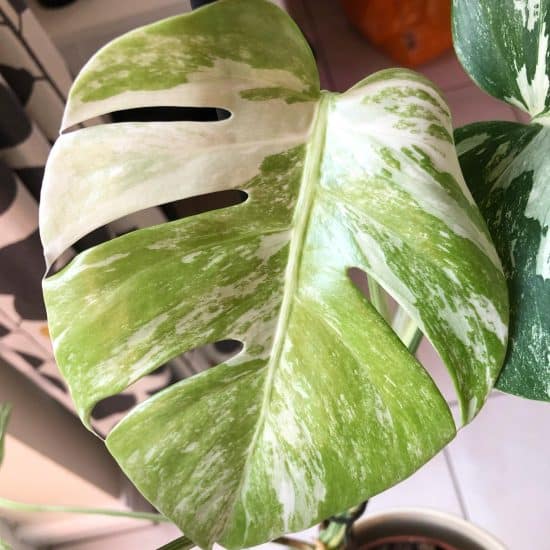
Monstera Albo – The same broad, bold, and boastful leaves of the deliciosa but with unique white variegation. Each has its own pattern, making them one-of-a-kind additions to your home. (Read our full Monstera albo guide here.)
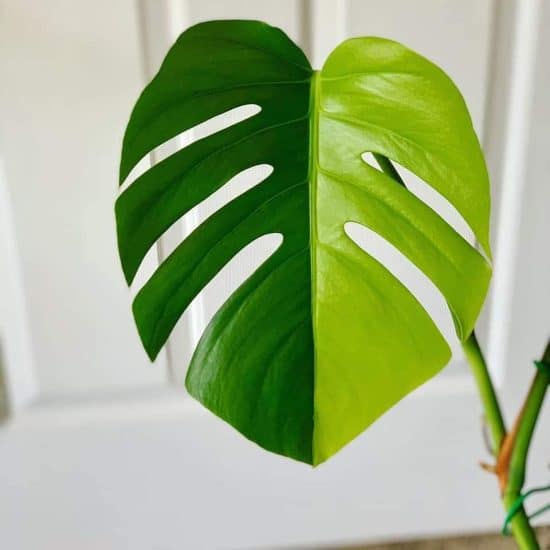
Monstera deliciosa ‘Aurea’ – Features a yellowish green variegation that ranges from an even light green in the above leaf (a rarity of the form) to yellowish variegation painted more wildly over the surface. Its fenestrated edges tend to get more complex as the plant matures.
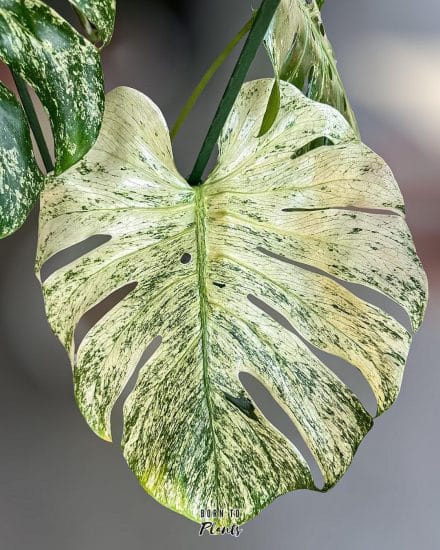
Monstera ‘White Monster‘ – Often confused with Monstera albo, the ‘White Monster’ has almost entirely white leaves. These cultivars require lots of indirect light and grow very slowly.
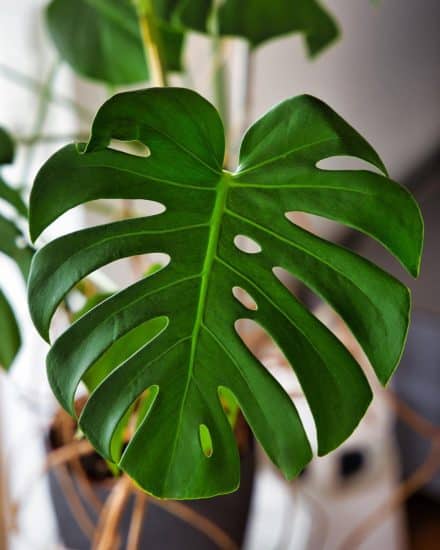
Monstera deliciosa ‘King’ – A larger-than-life variety that lives up to its name, the ‘King’ has massive leaves that command attention. Green coloration, often fewer fenestrations, and a majestic touch of the tropics. They tend to be hardy and can withstand frequent application of fertilizer to keep up with their growth.
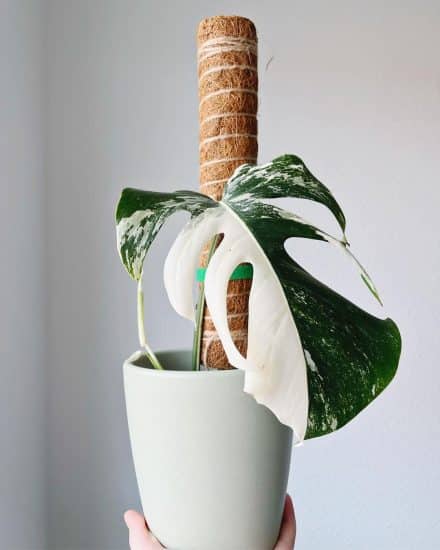
Monstera ‘Half Moon’ – An apt name, the ‘Half Moon’ showcases a curious and distinctive feature— a dramatic half-and-half coloration that splits the leaf into two equal parts of green and white. This variety is bound to spark conversation among your plant-loving friends.
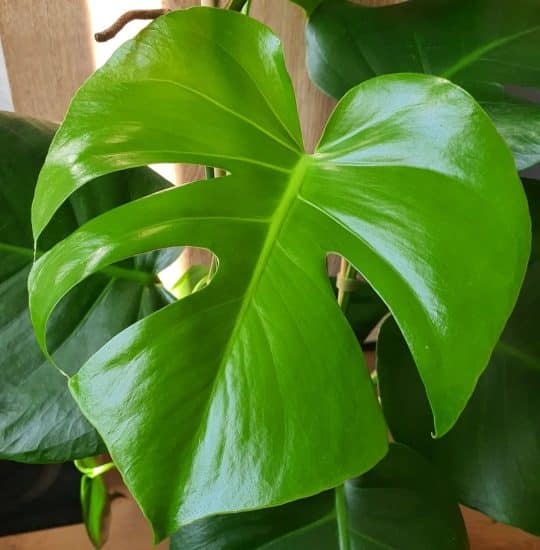
Monstera borsigiana – Often mistaken for the Monstera deliciosa, the borsigiana is a separate species with smaller leaves and a more compact growth habit. Its charming, split leaves and climbing nature make it perfect for smaller spaces or as a hanging plant. (Our full Monstera borsigiana guide is available here)
Monstera adansonii vs Monstera deliciosa
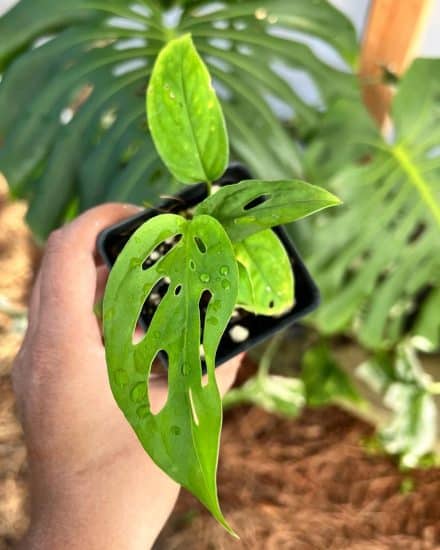
Ah, the great Monstera debate: which of these Swiss cheese plants is the true heir?
While both Monstera adansonii and Monstera deliciosa belong to the same family and share some similarities, they’re two distinct species with their own unique quirks.
Monstera adansonii has much smaller leaves that have holes rather than edge-fenestration. Unlike its deliciosa sibling, adansonii is a trailing plant that loves to hang and drape, although it can still do some climbing if given the opportunity. We generally refer to this one as the Swiss cheese plant, but you’ll see the term used widely.
The main differences between adansonii and deliciosa lie in their leaf size, shape, hole patterns, and growth habits. Both plants are gorgeous and make fantastic indoor additions, so you really can’t go wrong with either one!
(And don’t even get us started on Split leaf philodendron.)
Light
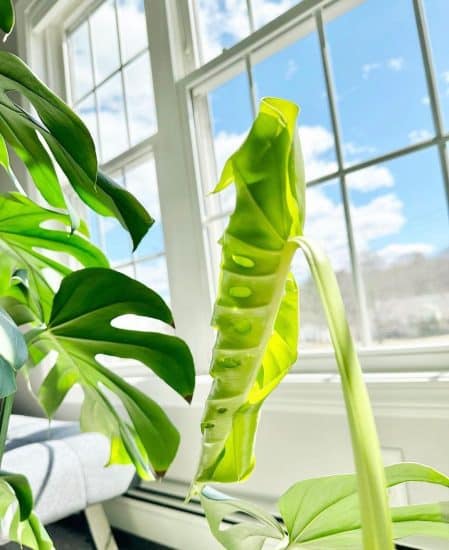
Let’s dive right into the best lighting conditions for your Monstera deliciosa.
First things first, where should you put your Monstera deliciosa plant? Well, the ideal location is near an east or north-facing window, where it can bask in bright, indirect light (you know, the kind that’s just right, without being too intense).
Morning and evening sun works wonders for this houseplant, but watch out for that harsh midday sun—it can cause serious leaf burn.
What if your only option is direct sun? No problem!
Just add a sheer curtain to keep your Monstera’s leaves protected. And don’t forget to rotate it regularly—this will help the monstera plant grow evenly.
If you’re noticing slow, leggy growth in your Monstera deliciosa plant, this could be a sign of not enough light. Are the leaves smaller and less holey than you expected? Is your plant desperately reaching for a light source?
If you answered “yes” to any of these questions, chances are your Monstera needs more light.
On the flip side, if your Monstera is getting too much light, you’ll see symptoms like:
- Yellow or brown spots on the leaves
- Curling or scorched leaf edges
- Faded, bleached-looking leaves
Reposition your Monstera deliciosa plant further away from the window or add a sheer curtain to soften the sunlight. Crisis averted!
Water
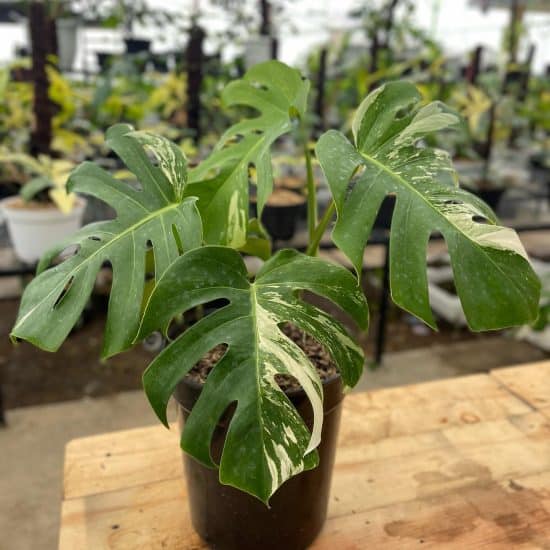
Monstera deliciosa enjoys a nice, thorough soak when it’s time for a drink. Now, about that watering schedule . . . toss it out the window.
You see, your Monstera is unique, just like you. It might need more or less water depending on its environment. So, when caring for a Monstera, keep an eye on that soil and let it tell you when it’s time for a drink.
When you do water your Monstera deliciosa, make sure the water makes its way through the entire pot and drains out the bottom.
(No soggy bottoms here, please. Ensure the pot has drainage holes to promote good drainage and to prevent excess water in the pot.)
And while we’re on the topic, double-check your pot for drainage holes — they’re lifesavers for your plant!
Not enough water: If you start to see browning or curling leaves, it’s like your Monstera is waving a little white flag and saying, “Hey, I’m thirsty!” Wilted or drooping leaves are also a cry for help. So, go ahead and increase your watering frequency — just don’t go overboard.
Too much water: You don’t want to drown your precious plant, or you’ll soon notice rot with yellowing and wilting leaves. If you see any of these scary signs, it’s time to scale back on the watering frequency. Remember: when in doubt, underwatering is better than overwatering. So, let that soil dry out a smidge more before your next watering.
Temperature and humidity
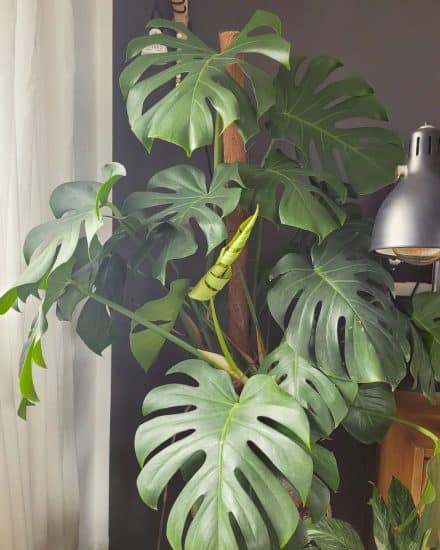
Caring for indoor plants like Monstera deliciosa means providing the right balance of temperature and humidity to keep them healthy and happy. Let’s discuss both of these factors and how to create the ideal environment for your tropical plant friend.
Monstera deliciosa is quite adaptable when it comes to temperature, generally thriving in the range of 60 to 85 degrees Fahrenheit. However, it’s important to maintain a consistent temperature, as it doesn’t like sudden changes or cold drafts.
Be mindful of your plant’s location, as placing it near windows, doors, or vents may expose it to fluctuating temperatures that could cause stress or damage.
Monsteras are right at home in higher humidity levels, around 55-80%, as they are tropical plants. While they can survive in standard household humidity, they will truly thrive when given a bit more moisture. If you see your Monstera’s leaves becoming dry or crunchy, it may be a sign that the humidity is too low.
Conversely, if you notice mold, mildew, or rot, it could mean that the humidity is too high or that there’s inadequate airflow around your plant.
Temperature and humidity care tips:
- Keep your Monstera deliciosa in a temperature range of 60-85°F, away from cold drafts and fluctuating temperatures.
- Aim for a humidity level of 60-80%, but remember that Monsteras are adaptable and can tolerate lower household humidity.
- To increase humidity, place your plant on a tray of water and pebbles, use a humidifier, or group it with other humidity-loving plants.
- Avoid misting the leaves directly, and gently wipe them with a damp cloth to remove dust and maintain their vibrant appearance.
Soil and Planting
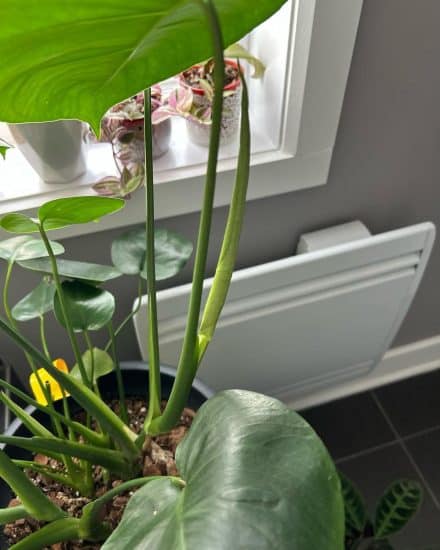
Monstera deliciosa thrives in a well-draining soil mix, such as an aroid mix. If you want to create your own potting mix for, we recommend the following ingredients and proportions:
- 50% regular potting soil
- 45% cacti soil
- 5% perlite
You can also add ingredients like coconut coir or orchid bark. These additions enhance drainage and aeration, making sure your Monstera deliciosa plants stay healthy and vibrant.
Monstera deliciosa plants like to be crowded in their pot, but as the plant grows, it may eventually need a larger container. When it’s time to repot, choose a new pot an inch or two larger in diameter than the current one, ensuring it has sufficient drainage holes.
Fertilizing
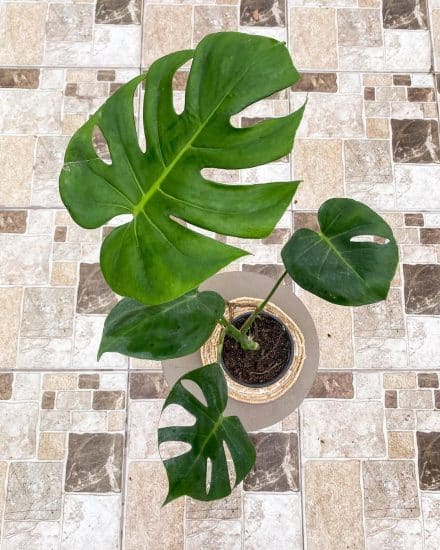
During the growing season, care for a Monstera by fertilizing your Monstera deliciosa plants once a month using a liquid balanced fertilizer. However, you’ll want to dilute it to around 50%. You can also hold off completely during the winter, and make sure to start slow.
Be cautious of overfertilizing, as it can lead to symptoms like leaf burn, yellowing, or curling. If you suspect you’ve added too much fertilizer, flush the soil with water to remove excess nutrients and prevent further damage.
Propagation Guide
That’s right, it’s time to cover how to propagate Monstera deliciosa. We’ll walk you through the process of stem cutting propagation, which can be done in water or soil.
And guess what? You can even do this in winter if you need to!
Propagating monstera plants in water:
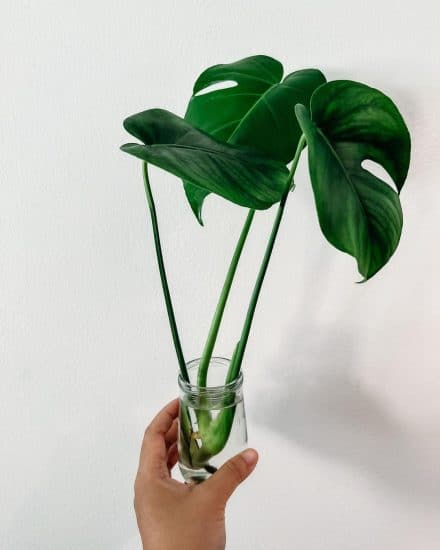
- Snip off a happy, healthy stem from your Monstera deliciosa that has a node or standout aerial root. Make sure the cutting has one or two leaves that measure about 4-6 inches long.
- Remove any leaves around the node or aerial root, as they might get mushy in water.
- Place your cutting into a jar or container filled with filtered water. Submerge only the node or aerial root; you don’t want the leaves taking a swim!
- Find a spot with bright, indirect light for your container. Give the water a refresh every few days to keep it clean.
- Keep an eye on your cutting over the next few weeks. Once you spot roots growing from the node or aerial root and reaching 2-3 inches long, it’s time to transplant it to soil.
Propagating Monstera deliciosa in soil:
- Grab a pot with drainage holes ready with a well-draining soil mix.
- Snip and plant the cutting directly into the soil, covering the node or aerial root but keeping the leaves above ground.
- Water your container thoroughly, ensuring the soil is moist but not drowning.
- Keep it in a humid environment by covering the plant with a plastic bag or using a humidity tray.
- Watch your baby plant over a few weeks, maintaining consistently moist soil. Once it starts showing off some new growth, you’ll know it’s rooted and happy.
Our tips:
- Cleanliness is key! Use a sterilized pair of pruning shears or scissors to make your cuttings and avoid any nasty infections or plant injuries.
- Growing roots takes time, so patience is a virtue. Remember, it can take a few weeks for roots to develop and strengthen for transplanting.
- Try your best to propagate during the growing season in spring or summer. But if you need to do it in winter, no worries! Just make sure you provide plenty of light and humidity for your cutting.
Common Issues
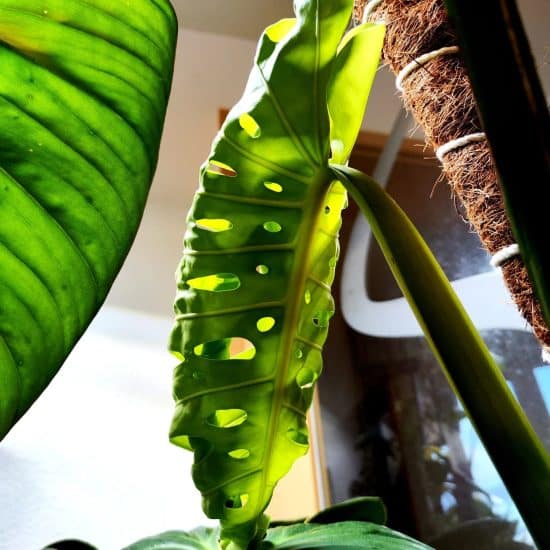
Indoor plants like Monstera deliciosa all suffer from issues from time to time, but we’ll do our best to cover the ones we see the most.
Running out of space
You know how Monstera deliciosa can grow pretty quickly? Well, sometimes they can outgrow the space you’ve given them (oops!).
If you notice your plant’s leaves bunching up, or maybe its stems with aerial roots are reaching for the walls, then it’s probably time to address the space issue.
Fret not, dear plant parent! One solution is guiding your plant with a moss pole so it stays within its pot . . . think of it as plant training!
Stunted Growth
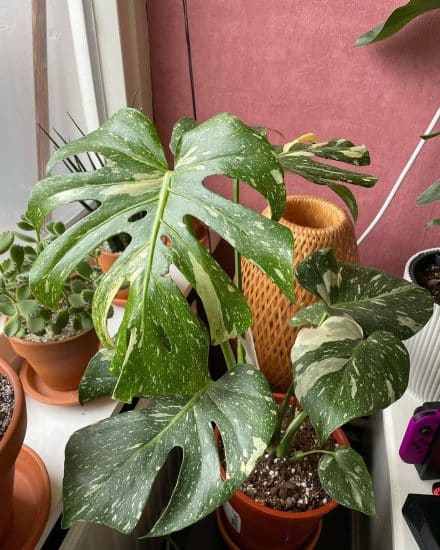
If you spot smaller leaves and slow new growth development, something’s definitely up. But don’t worry, we’ll figure it out together!
Causes can range from overwatering and incorrect fertilization to poor lighting (understanding the cause-and-effect relationship is so important!).
Let’s start by making sure your plant is receiving the right amount of direct light. Then, double-check your watering: allow the dry soil to dry out between waterings so you don’t drown the poor thing!
Last but not least, avoid over-fertilizing, which could lead to wilting leaves or leaves that turn yellow . . . which can cause nasty fertilizer burn. Stick to a balanced, water-soluble fertilizer at half strength, once a month during the growing season.
Why do Monstera leaves turn brown?
Brown leaves are typically due to one of the following issues:
- Underwatering: If your Monstera’s leaves are crispy and brown around the edges, it might be signaling that it’s thirsty! Remember to keep the soil consistently moist but never soggy.
- Overwatering: On the flip side, if you’re giving your Monstera too much love (read: water), this can lead to rot and you’ll notice mushy leaves. Really let the soil dry out a bit before watering.
- Low humidity: These indoor plants enjoy a humid environment. When the air is too dry, their leaves can become brown and crispy. Boost humidity levels using our tips mentioned earlier.
- Excess light: Harsh, direct sunlight can scorch those beautiful leaves, leaving behind brown patches or spots. Keep your Monstera in bright, indirect light to protect it from leaf burn.
Pests and diseases
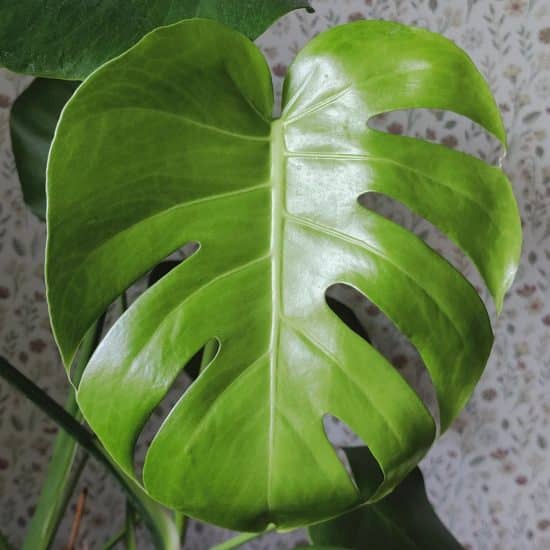
All right, let’s get into the common issues that could be bugging your leafy companion (pun intended) – we’re talking thrips and root rot.
Thrips
Thrips can be, well, pretty irritating for your precious Monstera deliciosa plant, especially when they target fresh, unfurling leaves. They’re tiny, sneaky little critters that feed on your plant’s cells, causing the foliage to look discolored and all kinds of funky.
To spot thrips, look for small, slender bugs that range in color from yellow to brown or black. Their damage might appear as silvery streaks, light spots, or curled leaves. You might need a magnifying glass to catch these guys in action . . . they’re pretty tiny!
First things first, give that plant a little personal space away from its neighbors to prevent any unwanted thrip parties. Use some water to gently rinse off the bugs, but for a more effective attack, neem oil is your best bet.
Make sure to cover both the top and underside of the leaves (thrips love hiding underneath!) and repeat treatment every 7-10 days, as needed.
Root rot
Root rot is an all-too-common headache for plant lovers, and your Monstera deliciosa isn’t immune to it, sadly. This pesky problem strikes when your plant’s roots sit in soggy soil for too long, leading to a fungal infection and – you guessed it – rotting roots!
Aerial roots may also suffer if they’re constantly damp or exposed to overly moist conditions.
Keep an eye out for warning signs like yellowing leaves or a mushy stem. If root rot is the culprit, take your Monstera deliciosa out of its pot and have a look at the roots. Healthy roots are firm and white, while the sickly ones are brown or black, soft, and slimy (yuck!).
Trim away any affected roots (including aerial roots) using sterilized scissors or pruning shears. Repot your Monstera deliciosa in fresh, well-draining soil in a new pot.
If the roots are still damp, you might want to consider wrapping them in sphagnum moss before repotting to help with moisture control.
Conclusion
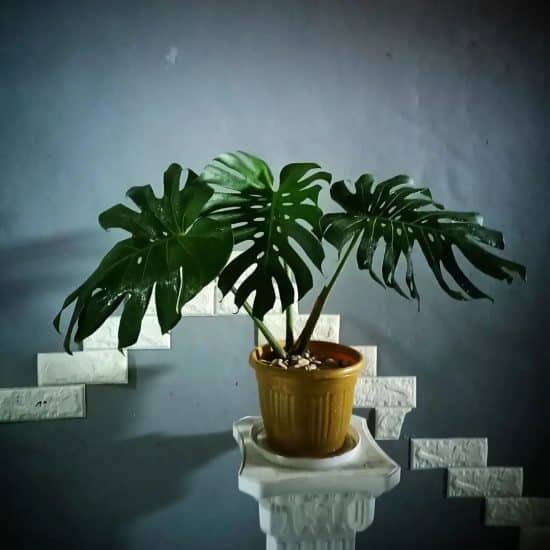
That’s it for our Monstera deliciosa care guide! We hope this guide has given you all the tools and knowledge you need to keep your plants happy, healthy, and thriving in your living space.
Monstera deliciosa care summary:
- Provide bright, indirect light and protection from harsh direct sunlight.
- Maintain a consistent temperature range of 60-85°F and aim for a humidity level of 50-80%.
- Use a well-draining soil mix, with a combination of potting mix, cacti soil, and perlite.
- Prune and repot as needed for optimal growth, and propagate using stem cuttings in water or soil.
Feel free to reach out to us if you have any questions that weren’t covered in this article, and don’t forget to share your newfound plant knowledge with a friend or two!
Take care, and happy growing!
FAQ
Can you plant outdoors?
Monstera deliciosa can definitely be planted outdoors, but bear in mind it’s a tropical plant and will thrive in warmer climates. If you’re living in USDA Hardiness Zones 10 and 11, your Monstera buddy will love soaking up the sun and fresh air outside.
However, if you reside in an area that experiences frost or harsh winters, it’s best to keep your plant indoors. Remember, Monsteras are sensitive to cold temperatures and won’t appreciate being subjected to chilly weather.
Can Monstera deliciosa tolerate low light levels?
Monstera deliciosa can tolerate low light, but it won’t be living its best life. In low-light conditions, your plant may experience slow growth, smaller leaves, and fewer of those iconic holes that make Monsteras a standout.
If possible, provide your Monstera with bright, indirect light (near an east or north-facing window) to keep it happy and healthy. If your space is limited to low-light conditions, consider rotating your plant between brighter and dimmer areas of your home, or use grow lights to supplement natural light.
What should I do with the aerial roots of my Monstera deliciosa?
Those curious, adventurous aerial roots are a natural part of your Monstera deliciosa’s growth. They can be a wonderful addition to your plant’s overall appearance or can be a bit unwieldy, depending on your aesthetic preference.
If you’d like to keep things tidy and maintain order, consider training your Monstera to climb a moss pole, trellis, or another support structure. This way, those aerial roots will have a place to attach and grow, keeping your plant neatly contained.
On the other hand, if you adore the wild, untamed look, feel free to let those aerial roots roam free!
Should I wipe my Monstera deliciosa down?
Every other week (or when watering) you can gently wipe the leaf surfaces with a soft cloth and water to remove any pesky dust that might be blocking the precious sunlight your plant is trying to accumulate.
Wiping leaves down is also great for discouraging spider mites, it’s something you should be able to practice for almost all Monstera plants.
Should I mist my Monstera deliciosa?
Misting your Monstera deliciosa can be a bit of a controversial topic! While these tropical beauties do appreciate a humid environment, misting the leaves directly isn’t the best approach.
Here’s why: misting can create a damp surface that invites fungal problems, and let’s be real – nobody wants that for their precious plant.

